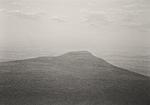I use a little printfile folding contact printer. Cheap and effective, (though the glass on some of them has defects even new!) Any good glass will do. I've been tempted to buy a replacement glass for a scanner off ebay. Very good glass I expect. You can just use a loose piece of window glass on the enlarger base, (Weston did), but the printfile is very handy and the rubber feet built into the base keep it in the same place. Window glass usually slightly green but doesn't seem to matter.
If you use a loose piece of window glass, tape the edges with black tape for handling and mark your contact printing area on the enlarger base with a couple of pieces of masking tape so you can see it in the safelights. Loose glass needs to be slightly bigger than the paper. 8X10 paper under a piece about 12X10. Give yourself a little rattle space.
My advice is to use a print file proofer. Skip the loose glass.
The enlarger, with the biggest negative carrier inserted, ought to be checked for an even illumination field. Put in a piece of paper and expose it at about Zone VI. Look for even-ness of exposure.
You want the light field to generously cover the contact printer glass, but not spill all over the enlarging table.
I stop down a few stops to get the exposure time in the 15-30 second range so that there will be plenty of time to dodge and burn. You'll need a tape dot on a piece of coathanger wire (about 3 inches in diameter with a 1 inch on the other end) for a dodging tool and a BLACK card about 11X7 for contacting on 8X10 paper. For the dodging tool, just twist a coathanger apart and cut out a couple sections with the wirecutter built into most pliers. Curl both ends with pliers and use some kind of dark tape to make a dot. Dress it up with scissors. I like a big oval on one end and a little circle on the other. Don't make the handle too long. (They look cheap but last for about 30 years.) There will be dodging and burning just like an enlargement.
I'm using Ilford Multigrade Warmtone, though I hear talk about other papers and you ought to pay attention to it. I like the response and color of multigrade. I'm using a modern enlarger lamp LED head that Cemil worked up and filters under the lens. Ilford MGWT very responsive to that enlarger head.
I've got another enlarger with a 4X5 aristo head. Useless for MG. I can't contact or enlarge with that cool light head. Too contrasty. I do have ANOTHER enlarger within reach that has a tungsten bulb. It would work. I use it for pre-fogging when I need to bring highlights down and keep it set to do just that.
I'd like to leave one enlarger set up to contact all the time in these enlarger-rich days. Might move off the Modern Enlarger Lamp set-up to the tungsten and try it. I have to use the MEL head to enlarge so that means moving the contact set-up out of the way.
Got a Zone VI with Aristo variable contrast head but it is for the most part, a disaster. I keep poking at it but it's over-complicated and just not very good. Next incarnation is with the original head back on, but with the tubes out and LEDs in. We'll see.
Canned air and photowipes on hand, of course.
Now you know everything I know, plus more, I'm sure!




 Reply With Quote
Reply With Quote





Bookmarks